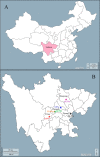Molecular typing and prevalence of antibiotic resistance and virulence genes in Streptococcus agalactiae isolated from Chinese dairy cows with clinical mastitis
- PMID: 35522690
- PMCID: PMC9075616
- DOI: 10.1371/journal.pone.0268262
Molecular typing and prevalence of antibiotic resistance and virulence genes in Streptococcus agalactiae isolated from Chinese dairy cows with clinical mastitis
Abstract
Bovine mastitis is a common disease occurring in dairy farms and can be caused by more than 150 species of pathogenic bacteria. One of the most common causative organisms is Streptococcus agalactiae, which is also potentially harmful to humans and aquatic animals. At present, research on S. agalactiae in China is mostly concentrated in the northern region, with limited research in the southeastern and southwestern regions. In this study, a total of 313 clinical mastitis samples from large-scale dairy farms in five regions of Sichuan were collected for isolation of S. agalactiae. The epidemiological distribution of S. agalactiae was inferred by serotyping isolates with multiplex polymerase chain reaction. Susceptibility testing and drug resistance genes were detected to guide the clinical use of antibiotics. Virulence genes were also detected to deduce the pathogenicity of S. agalactiae in Sichuan Province. One hundred and five strains of S. agalactiae (33.6%) were isolated according to phenotypic features, biochemical characteristics, and 16S rRNA sequencing. Serotype multiplex polymerase chain reaction analysis showed that all isolates were of type Ia. The isolates were up to 100% sensitive to aminoglycosides (kanamycin, gentamicin, neomycin, and tobramycin), and the resistance rate to β-lactams (penicillin, amoxicillin, ceftazidime, and piperacillin) was up to 98.1%. The TEM gene (β-lactam-resistant) was detected in all isolates, which was in accordance with a drug-resistant phenotype. Analysis of virulence genes showed that all isolates harbored the cfb, cylE, fbsA, fbsB, hylB, and α-enolase genes and none harbored bac or lmb. These data could aid in the prevention and control of mastitis and improve our understanding of epidemiological trends in dairy cows infected with S. agalactiae in Sichuan Province.
Conflict of interest statement
The authors have declared that no competing interests exist.
Figures


Similar articles
-
Streptococcus agalactiae isolated from clinical mastitis cases on large dairy farms in north China: phenotype, genotype of antimicrobial resistance and virulence genes.Front Cell Infect Microbiol. 2024 Sep 4;14:1417299. doi: 10.3389/fcimb.2024.1417299. eCollection 2024. Front Cell Infect Microbiol. 2024. PMID: 39295731 Free PMC article.
-
Capsular Typing and Molecular Characterization of Streptococcus agalactiae Strains Isolated From Bovine Mastitis in Iran.Vet Med Sci. 2025 Mar;11(2):e70275. doi: 10.1002/vms3.70275. Vet Med Sci. 2025. PMID: 40110713 Free PMC article.
-
Molecular epidemiology, drug resistance, and virulence gene analysis of Streptococcus agalactiae isolates from dairy goats in backyard farms in China.Front Cell Infect Microbiol. 2023 Jan 9;12:1049167. doi: 10.3389/fcimb.2022.1049167. eCollection 2022. Front Cell Infect Microbiol. 2023. PMID: 36699728 Free PMC article.
-
Streptococcus agalactiae mastitis: a review.Can Vet J. 1997 Jul;38(7):429-37. Can Vet J. 1997. PMID: 9220132 Free PMC article. Review.
-
Streptococcal infection and its antimicrobial resistance profile associated with bovine mastitis in Ethiopia: a systematic review and meta-analysis.Front Vet Sci. 2025 Mar 12;12:1503904. doi: 10.3389/fvets.2025.1503904. eCollection 2025. Front Vet Sci. 2025. PMID: 40144523 Free PMC article.
Cited by
-
Pharmacological composition based on bacteriocinnisin in experiments in vitro and in vivo.Open Vet J. 2024 Jun;14(6):1370-1383. doi: 10.5455/OVJ.2024.v14.i6.5. Epub 2024 Jun 30. Open Vet J. 2024. PMID: 39055763 Free PMC article.
-
Relationship between Biofilm Production and High Somatic Cell Count in Streptococcus agalactiae Isolated from Milk of Cows with Subclinical Mastitis.Pathogens. 2023 Feb 14;12(2):311. doi: 10.3390/pathogens12020311. Pathogens. 2023. PMID: 36839583 Free PMC article.
-
Effect of Selected Micro- and Macroelements and Vitamins on the Genome Stability of Bovine Embryo Transfer Recipients following In Vitro Fertilization.Animals (Basel). 2023 Mar 14;13(6):1056. doi: 10.3390/ani13061056. Animals (Basel). 2023. PMID: 36978597 Free PMC article.
-
Characterization of Virulence Factors and Antimicrobial Susceptibility of Streptococcus agalactiae Associated with Bovine Mastitis Cases in Thailand.Animals (Basel). 2024 Jan 30;14(3):447. doi: 10.3390/ani14030447. Animals (Basel). 2024. PMID: 38338090 Free PMC article.
-
A Review on Bioengineering the Bovine Mammary Gland: The Role of the Extracellular Matrix and Reconstruction Prospects.Bioengineering (Basel). 2025 May 9;12(5):501. doi: 10.3390/bioengineering12050501. Bioengineering (Basel). 2025. PMID: 40428120 Free PMC article. Review.
References
-
- Murphy JM. The genesis of bovine udder infection and mastitis; the occurrence of streptococcal infection in a cow population during a seven-year period and its relationship to age. Am J Vet Res. 1947;8(26):29–42. - PubMed
-
- Cobo-Ángel C, Jaramillo-Jaramillo AS, Lasso-Rojas LM, Aguilar-Marin SB, Sanchez J, Rodriguez-Lecompte JC, et al.. Streptococcus agalactiae is not always an obligate intramammary pathogen: Molecular epidemiology of GBS from milk, feces and environment in Colombian dairy herds. PloS one. 2018;13(12):e0208990–e. doi: 10.1371/journal.pone.0208990 - DOI - PMC - PubMed
Publication types
MeSH terms
Substances
LinkOut - more resources
Full Text Sources
Medical
Miscellaneous

